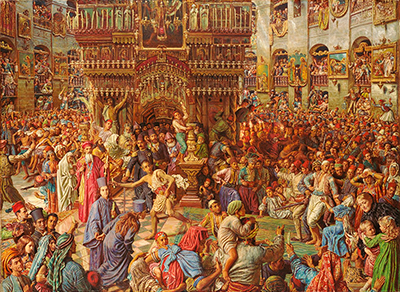The satirisation of things considered excessively holy is a common theme in the work of Hunt as well as Hogarth, one of Hunt's most notable influences. This is apparent in The Miracle of the Holy Fire, which was painted with oil and resin on canvas sometime between 1892 and 1899.
The rather large frame contains a confusing array of disorganised attendees from various backgrounds and ethnicities at the Easter Eve annual ritual held in Jerusalem's Church of the Holy Sepulchre. Rather than portraying a ritual procession in orderly veneration, Hunt chose to emphasise the degenerate behaviour and confusion he witnessed on his trip to the Holy Land nearly forty years prior to commencing this work. The ritual involves the city’s Greek Patriarch, who enters the Church of the Holy Sepulchre to the chanting of Kyrie eleison with an unlit oil lamp and emerges with a lit lamp. According to Hunt and other contemporaries of his time, this entire ceremony was a sham miracle and resulted in violence, including murder, as various groups of Christians would attempt to interfere with each other's masses and ceremonies.
Amongst the figures depicted around the frame, Greeks and Latins can be found as well as an out-of-place English Protestant mother in the bottom right corner, who is shielding her children from the madness around her. The Greek Patriarch emerges with the lit lamp on the right, but he is barely noticeable due to the chaos on all sides. On the far left, a pilgrim is seen being carried off in a fashion resembling the carrying of Christ from the cross to the tomb. Immediately to the right is another figure posing like Jesus on the cross. In an attempt to contrast order with chaos, we see the Ottoman ruler of Jerusalem before the Sepulchre.
Immediately in front of him his second in command, Bim Pasha, who leans on his sword whilst the crowd swings from statues and shouts from the balconies like bloodthirsty revellers in a Roman amphitheatre. Hunt left this painting with family upon his death, and it was subsequently passed around to private collections until being acquired by the Fogg Museum at the Harvard Art Museums in 1942 where it is currently located. His style is of the Pre-Raphaelite Brotherhood and many of his other paintings are also of a religious nature.




